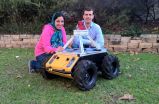Lonely galaxy lost in space
Hubble Space Telescope sees NGC 650
2015-06-10
(Press-News.org) Most galaxies are clumped together in groups or clusters. A neighboring galaxy is never far away. But this galaxy, known as NGC 6503, has found itself in a lonely position, at the edge of a strangely empty patch of space called the Local Void.
The Local Void is a huge stretch of space that is at least 150 million light-years across. It seems completely empty of stars or galaxies. The galaxy's odd location on the edge of this never-land led stargazer Stephen James O'Meara to dub it the "Lost-In-Space galaxy" in his 2007 book, Hidden Treasures.
NGC 6503 is 18 million light-years away from us in the northern circumpolar constellation of Draco. NGC 6503 spans some 30,000 light-years, about a third of the size of the Milky Way.
This Hubble Space Telescope image shows NGC 6503 in striking detail and with a rich set of colors. Bright red patches of gas can be seen scattered through its swirling spiral arms, mixed with bright blue regions that contain newly forming stars. Dark brown dust lanes snake across the galaxy's bright arms and center, giving it a mottled appearance.
The Hubble Advanced Camera for Surveys data for NGC 6503 were taken in April 2003, and the Wide Field Camera 3 data were taken in August 2013.
The Hubble Space Telescope is a project of international cooperation between NASA and the European Space Agency. NASA's Goddard Space Flight Center in Greenbelt, Maryland, manages the telescope. The Space Telescope Science Institute (STScI) in Baltimore conducts Hubble science operations. STScI is operated for NASA by the Association of Universities for Research in Astronomy, Inc., in Washington, D.C.
INFORMATION:
For images and more information about the Hubble Space Telescope, visit: http://www.nasa.gov/hubble or http://hubblesite.org/news/2015/23
[Attachments] See images for this press release:

ELSE PRESS RELEASES FROM THIS DATE:
2015-06-10
New research from UBC and the Child & Family Research Institute at BC Children's Hospital shows that risky outdoor play is not only good for children's health but also encourages creativity, social skills and resilience.
The findings, published in the International Journal of Environmental Research and Public Health, found that children who participated in physical activity such as climbing and jumping, rough and tumble play and exploring alone, displayed greater physical and social health.
"We found that play environments where children could take risks promoted increased ...
2015-06-10
Google searches for information on melanoma and skin cancer increased over the summer months during a five-year period, although the level of interest did not correlate with the melanoma mortality to incidence ratio, suggesting that increased search volumes may not be associated with early detection, according to a research letter published online by JAMA Dermatology.
Researcher Kyle T. Amber, M.D., of MacNeal Hospital, Berwyn, Ill., and coauthors used Google Trends, a research tool which quantifies interest in topics at the population level by analyzing all search queries ...
2015-06-10
For years, research on nuclear weapons has relied on old data, limited experiments and computer modeling. But this year, that pattern has changed. Scientists have run new experiments that simulate what happens to plutonium in a nuclear explosion, according to an article in Chemical & Engineering News (C&EN), the weekly newsmagazine of the American Chemical Society. The research will deepen scientists' understanding of the element -- and help them analyze a nuclear event should one occur.
In the article, Jyllian Kemsley, a senior editor at C&EN, notes that six years ago, ...
2015-06-10
Using the intestinal hormone GLP-1 in obesity treatment prevents the loss of bone mass otherwise frequently associated with major weight loss. This is the finding of a new study from the University of Copenhagen, Hvidovre and Glostrup Hospital. According to the researchers behind the study, the results may have a significant bearing on future obesity treatment.
Rapid weight loss leads to a loss of bone mass and an increased risk of bone fractures. New research shows that treating obesity with the GLP-1 hormone helps prevent loss of bone mass in addition to having a number ...
2015-06-10
June 10, 2015--Low-income families bear the brunt of high-energy costs and poor thermal comfort from poorly maintained apartment buildings. To study how energy efficiency upgrades could help these households, researchers at Columbia University's Mailman School of Public Health surveyed residents in a low-income community in New York City. They found that while energy efficiency upgrades varied significantly by ownership status, low-income single-family homeowners reaped the greatest direct benefits. Results overall showed that respondents experienced improved thermal comfort, ...
2015-06-10
WASHINGTON - While a 1980 reform law enabled the modernization and stabilization of the U.S. freight railroad industry, federal regulation has not kept pace with the industry's transformation and should be replaced with a system better-suited for today's freight rail system, says a new congressionally mandated report from the National Research Council's Transportation Research Board. Current policies designed to protect rail shippers who lack transportation options from excessive rates are not working for shippers of most commodities, including grain. More appropriate, ...
2015-06-10
The way insects see and track their prey is being applied to a new robot under development at the University of Adelaide, in the hopes of improving robot visual systems.
The project - which crosses the boundaries of neuroscience, mechanical engineering and computer science - builds on years of research into insect vision at the University.
In a new paper published today in the Journal of The Royal Society Interface, researchers describe how the learnings from both insects and humans can be applied in a model virtual reality simulation, enabling an artificial intelligence ...
2015-06-10
CHICAGO (June 10, 2015): As health insurers place more emphasis on paying for quality outcomes rather than for specific services provided by doctors and hospitals, several quality improvement programs have been developed as a way to help health care providers identify problem areas and share best practices. While some studies have evaluated how well these quality improvement programs achieve their goals, not many have focused on the area of trauma care. But now a team of trauma surgeons at the University of Michigan in Ann Arbor have reported how data from a statewide ...
2015-06-10
Origami, the Japanese art of paper folding, can be used to create beautiful birds, frogs and other small sculptures. Now a Binghamton University engineer says the technique can be applied to building batteries, too.
Seokheun "Sean" Choi developed an inexpensive, bacteria-powered battery made from paper, he writes in the July edition of the journal Nano Energy.
The battery generates power from microbial respiration, delivering enough energy to run a paper-based biosensor with nothing more than a drop of bacteria-containing liquid. "Dirty water has a lot of organic matter," ...
2015-06-10
DARIEN, IL - A new study suggests that one night of partial sleep deprivation promotes biological aging in older adults.
Results show that one night of partial sleep deprivation activates gene expression patterns in peripheral blood mononuclear cells (PBMCs) consistent with increasing accumulation of damage that initiates cell cycle arrest and increases susceptibility to senescence. These findings causally link sleep deprivation to the etiology of biological aging, and further supports the hypothesis that sleep deprivation may be associated with elevated disease risk ...
LAST 30 PRESS RELEASES:
[Press-News.org] Lonely galaxy lost in space
Hubble Space Telescope sees NGC 650


